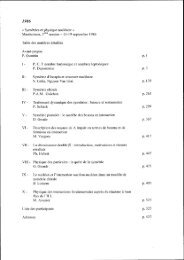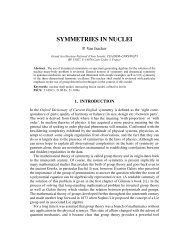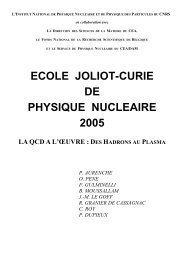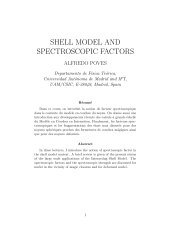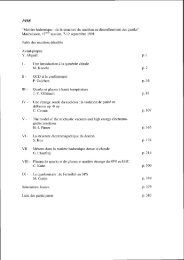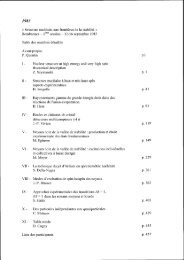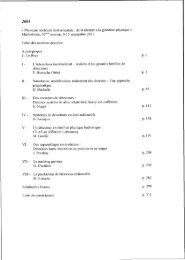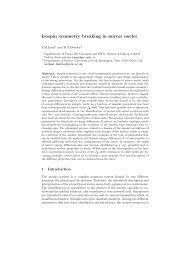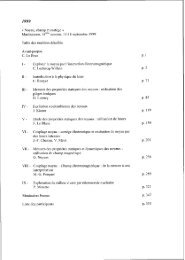- Page 1 and 2:
ECOLE INTERNATIONALE JOLIOT-CURIE D
- Page 3 and 4:
Cours enseignés aux précédentes
- Page 5 and 6:
TABLE DES MATIERES AVANT-PROPOS M.-
- Page 7 and 8:
MESURES DE SECTIONS EFFICACES D'INT
- Page 9 and 10:
SYSTÈMES DU FUTUR ET STRATÉGIES S
- Page 11 and 12:
AVANT-PROPOS Je dédie ce volume de
- Page 13 and 14:
LA FISSION : DE LA PHÉNOMÉNOLOGIE
- Page 15 and 16:
2 Un peu d’histoire 2.1 La décou
- Page 17 and 18:
axe transverse), a 3 sa déformatio
- Page 19 and 20:
Lorsque les paramètres de déforma
- Page 21 and 22:
veaux de neutrons en fonction d’u
- Page 23 and 24:
La méthode de Strutinski est emplo
- Page 25 and 26:
L’existence d’un tel îlot est
- Page 27 and 28:
Fig. 2 - Demi-vie de la fission spo
- Page 29 and 30:
les résonances deviennent extrême
- Page 31 and 32:
Fig. 5 - A gauche, distributions en
- Page 33 and 34:
Fig. 6 - A gauche, distributions en
- Page 35 and 36:
donne la distribution de l’énerg
- Page 37 and 38:
Fig. 10 - En haut, énergie cinéti
- Page 39 and 40:
généralement négative. Dans cert
- Page 41 and 42:
Fig. 12 - Distributions du nombre d
- Page 43 and 44:
Fig. 13 - A gauche, surface d’én
- Page 45 and 46:
Fig. 14 - A gauche, hauteurs de la
- Page 47 and 48:
où T A et T b sont les pénétrabi
- Page 49 and 50:
du calcul des sections efficaces de
- Page 51 and 52:
Γ c r =|γc r |2 : Γ r = ∑ c |
- Page 53 and 54:
Fig. 18 - Représentation des diver
- Page 55 and 56:
temps très différentes pour les d
- Page 57 and 58:
nucléaires plus précises et couvr
- Page 59 and 60:
Fig. 20 - A gauche, surface d’én
- Page 61 and 62:
kins les énergies de déformation
- Page 63 and 64:
Fig. 22 - A gauche, surface d’én
- Page 65 and 66:
Fig. 24 - Surface d’énergie pote
- Page 67 and 68:
des résultats obtenus dans cette
- Page 69 and 70:
De fait, les évaluations réalisé
- Page 71 and 72:
[52] D. L. Hill and J. A. Wheeler,
- Page 73 and 74:
Physique des Réacteurs Nucléaires
- Page 75 and 76:
6 Types de reacteurs nucleaires....
- Page 77 and 78:
Figure 1: Lien entre l'énergie moy
- Page 79 and 80:
énergie potentielle à l'atome. L'
- Page 81 and 82:
Figure 3: Section efficace microsco
- Page 83 and 84:
Ces valeurs seront utilisées en ph
- Page 85 and 86:
• en maintenant élevée la secti
- Page 87 and 88:
La probabilité de non-fuite, sous
- Page 89 and 90:
Nous choisissons comme un volume un
- Page 91 and 92:
2.1.3 Distribution de flux dans le
- Page 93 and 94:
Pour des réacteurs de même compos
- Page 95 and 96:
D Δ ϕ + ν Σ ϕ −Σ ϕ + ν Σ
- Page 97 and 98:
μ = ∑ μ μ P ( μ) (54) Les neu
- Page 99 and 100:
comparaison montre l'importance de
- Page 101 and 102:
Δt Δ n + p = ( 1− β ) keff n (
- Page 103 and 104:
3.4 Comportement cinétique avec ne
- Page 105 and 106:
De cette étude de la période du r
- Page 107 and 108:
4 CONTRÔLE DU RÉACTEUR 4.1 Princi
- Page 109 and 110:
n = Sl 2 ( 1+ k + k + ..) Sl SΛ Sl
- Page 111 and 112:
Figure 18: Evolution de 1/n det en
- Page 113 and 114:
Figure 21: Efficacité différentie
- Page 115 and 116:
5 DYNAMIQUE DES RÉACTEURS NUCLÉAI
- Page 117 and 118:
combustible d F dT ρ et un pour le
- Page 119 and 120:
235, U-233), le comportement en 1/v
- Page 121 and 122:
σ poison N poison Δρ = − f (11
- Page 123 and 124:
L'évolution de la concentration de
- Page 125 and 126:
Figure 28: L'évolution de l'anti-r
- Page 127 and 128:
Pressurised Heavy Water Reactor “
- Page 129 and 130:
Figure 30: Schéma de principe de f
- Page 131 and 132:
Figure 32: Schéma de principe de f
- Page 133 and 134:
2005 Korea RO Ulchin 6 PWR (KSNP) 9
- Page 135 and 136:
puissante pour les sous-marins. La
- Page 137 and 138:
adioactifs et ceux contenant des é
- Page 139 and 140:
Modélisation et Evaluation de Donn
- Page 141 and 142:
demandées aux évaluations par les
- Page 143 and 144:
Photographie de l’expérience JEZ
- Page 145 and 146:
Un exemple de données nucléaires
- Page 147 and 148:
Γ b . Malheureusement, comme il n
- Page 149 and 150:
efficaces de réaction et shape ela
- Page 151 and 152:
Signalons cependant que des études
- Page 153 and 154:
Le choix entre les approches phéno
- Page 155 and 156:
Comme la section efficace de réact
- Page 157 and 158:
Jusque là nous n’avons discuté
- Page 159 and 160:
avec a le paramètre dit « de dens
- Page 161 and 162:
l’énergie du neutron soit suffis
- Page 163 and 164:
Si l’on revient un instant en arr
- Page 165 and 166:
Schéma des modules du code TALYS h
- Page 167 and 168:
Lorsque les données nucléaires é
- Page 169 and 170:
Nous nous sommes placés dans un ca
- Page 171 and 172:
Sections efficaces de mesurée (sym
- Page 173 and 174:
Résultats de calculs de benchmarks
- Page 175 and 176:
très favorablement aux données ex
- Page 177 and 178:
238 U sont qualitativement en bon a
- Page 179 and 180:
Mesure de sections efficaces d’in
- Page 181 and 182:
d’énergie E n arrivant sur celle
- Page 183 and 184:
modèle optique, σ NC peut être c
- Page 185 and 186:
car ∑ J , π P = P ( E*) ⋅ ∑
- Page 187 and 188:
la partie droite de la figure 4 [4]
- Page 189 and 190:
mesurer la distribution angulaire d
- Page 191 and 192:
données expérimentales de Vorotni
- Page 193 and 194:
Une version plus sophistiquée de n
- Page 195 and 196:
Données et modélisation de la spa
- Page 197 and 198:
noyaux résiduels de spallation qui
- Page 199 and 200:
Un faisceau de noyaux légers est d
- Page 201 and 202:
sur les neutrons à haute énergie.
- Page 203 and 204:
Un tel détecteur est constitué d
- Page 205 and 206:
Fig 12: Sections efficaces doubleme
- Page 207 and 208:
CaF2 (signal DE) et de scintillateu
- Page 209 and 210:
de validité des modèles de cascad
- Page 211 and 212:
10 -6 1 10 10 2 Neutrons /proton /M
- Page 213 and 214:
1000MeV Pb+p, INCL43 ABLAV3p 2005/0
- Page 215 and 216:
B- Modélisation de la spallation E
- Page 217 and 218:
α(Exp(a.cos(θ)) + Exp(-a.cos(θ))
- Page 219 and 220:
Fig 35 : Caractéristiques de diff
- Page 221 and 222:
la distribution de masse des produi
- Page 223 and 224:
d’amélioration important (évapo
- Page 225 and 226:
éventuels d’un nucléon qui s’
- Page 227 and 228:
10 2 Fe + p INCL4-GEMINI INCL4-GEM
- Page 229 and 230:
A condition de prendre en compte la
- Page 231 and 232:
particulier le recoupement avec les
- Page 233 and 234:
Ref 29 : C. Kalbach, Phys. Rev. C33
- Page 235 and 236:
Déchets nucléaires : état des li
- Page 237 and 238:
I. INTRODUCTION Il m’a paru essen
- Page 239 and 240:
Hague (nommées UP2 et UP3 ; UP1 es
- Page 241 and 242:
présence conduit à l’accumulati
- Page 243 and 244:
taxe sur les MW vendus a été effe
- Page 245 and 246:
En conclusion : « la transmutation
- Page 247 and 248:
En 1998, en France, la production d
- Page 249 and 250:
de concentration final dépend beau
- Page 251 and 252:
En ce qui concerne les déchets en
- Page 253 and 254:
IV. 2. 4. Le stockage est-il défin
- Page 255 and 256:
4) Les modifications géologiques
- Page 257 and 258:
le pH, la chaleur ou la pression (o
- Page 259 and 260:
COMMUNIQUE DE PRESSE DU GROUPE AREV
- Page 261 and 262:
Processus et faisabilité de la tra
- Page 263 and 264:
Sommaire 1 Les bases physiques de l
- Page 265 and 266:
Le principe de la transmutation con
- Page 267 and 268:
Section efficace 99 Tc (n,γ) Captu
- Page 269 and 270:
Figure n° 3 : Section efficace de
- Page 271 and 272:
Isotope Réacteur à neutrons lents
- Page 273 and 274:
243 Cm 242 Am 235 U 236 U 237 U 238
- Page 275 and 276:
400 350 Rapport des masses produite
- Page 277 and 278:
• La nécessité de procéder à
- Page 279 and 280:
La figure suivante, montre l’inci
- Page 281 and 282:
Le remplacement d’U238 par du Np
- Page 283 and 284:
Dans un spectre de réacteur REP, p
- Page 285 and 286:
5 Incidence du mode de recyclage de
- Page 287 and 288:
Production (kg/Twhe) Isotope Pério
- Page 289 and 290:
8 Simulation : démarche et motivat
- Page 291 and 292:
possibilité de s’affranchir d’
- Page 293 and 294:
σ i eff = ΔEi ∫ σ( E) Φ( E) d
- Page 295 and 296:
combinant mesures microscopiques et
- Page 297 and 298:
Mesure et analyse des sections effi
- Page 299 and 300:
10.5.1 Exemple de validation des do
- Page 301 and 302:
11 Faisabilité technique de la tra
- Page 303 and 304:
longue, tant que l’on n’a pas a
- Page 305 and 306:
n’implique qu’un nombre limité
- Page 307 and 308:
12 kg/TWhe pour le neptunium (à un
- Page 309 and 310:
mode homogène dans le cœur des r
- Page 311 and 312:
inventaires est d’environ 15 ans
- Page 313 and 314:
Réacteurs hybrides : avancées ré
- Page 315 and 316:
Liste des notations [= …] notatio
- Page 317 and 318:
Introduction Depuis près de quinze
- Page 319 and 320:
éacteur sous-critique, il peut êt
- Page 321 and 322:
2. Le pilotage et le contrôle des
- Page 323 and 324:
permet de déduire la réactivité
- Page 325 and 326:
A Λ n0 = n0 (25) − ρ + β α p
- Page 327 and 328:
Celle s’ajustant au mieux aux don
- Page 329 and 330:
2.3.4.1. La méthode Rossi-alpha Le
- Page 331 and 332:
maîtrise de ce point est cruciale
- Page 333 and 334:
3.1.2. La cible de spallation Le ch
- Page 335 and 336:
accidents sévères comme la perte
- Page 337 and 338:
TRAnsmutation) de IP-EUROTRANS dans
- Page 339 and 340: de spallation est l’élément sur
- Page 341 and 342: 3.3.3. Le design de la cible de spa
- Page 343 and 344: 3.3.4. Le design du cœur sous-crit
- Page 345 and 346: Références [1] J.-M. Loiseaux, «
- Page 347 and 348: Systèmes du futur et stratégies S
- Page 349 and 350: 1 Contexte énergétique et nucléa
- Page 351 and 352: Source (Gtep/an) % Fossile dont Cha
- Page 353 and 354: gaz devrait suivre celui du pétrol
- Page 355 and 356: 2 La situation en France Tous les r
- Page 357 and 358: 2.2 Le combustible MOX Le plutonium
- Page 359 and 360: Réduire le taux de rejet de l’ 2
- Page 361 and 362: Le plutonium quant à lui est essen
- Page 363 and 364: On constate donc que les filières
- Page 365 and 366: (1+α) : nombre de neutrons captur
- Page 367 and 368: 270°C environ, mais pour le sodium
- Page 369 and 370: faire diminuer l’inventaire total
- Page 371 and 372: 5 Les réacteurs rapides 5.1 Les di
- Page 373 and 374: le détail. Il s’agit du parc fra
- Page 375 and 376: Durant 5 années de fonctionnement
- Page 377 and 378: Le réacteur a été modélisé fid
- Page 379 and 380: Le coefficient de température peut
- Page 381 and 382: Une transition au niveau français
- Page 383 and 384: Une transition à puissance croissa
- Page 385 and 386: mineurs, ce conditionnement étant
- Page 387 and 388: discussions enflammées au sujet de
- Page 389: Les énergies autres que le nucléa
- Page 393 and 394: par un barrage hydroélectrique le
- Page 395 and 396: statistiques de l’AIE pour l’ex
- Page 397 and 398: 12000 10000 Consommation Mtep 8000
- Page 399 and 400: habitant. Ce scénario tend à réd
- Page 401 and 402: 4 Les combustibles fossiles Rappelo
- Page 403 and 404: Les gaz d’échappement de la turb
- Page 405 and 406: H H O H H H O H N C C + CO 2 N C C
- Page 407 and 408: 5 Les énergie renouvelables contin
- Page 409 and 410: • 12 Mtonnes de déchets ménager
- Page 411 and 412: (1.000 à 1.500 ° C) en pression e
- Page 413 and 414: 5.2.1.2 Les aménagements « au fil
- Page 415 and 416: La Chine produit actuellement 1600
- Page 417 and 418: 16 P max = P 27 0 Équation 4 Cette
- Page 419 and 420: Comme la vitesse relative U est pro
- Page 421 and 422: Figure 10 Exemple d’évolution de
- Page 423 and 424: Il est clair que, si l’on désire
- Page 425 and 426: 6.2 Le Solaire (chapitres 17 et 18)
- Page 427 and 428: Le temps de retour énergétique de
- Page 429 and 430: Cette comparaison faite sur le Tabl
- Page 431 and 432: 15000 €. Même sans subvention ni
- Page 433 and 434: Ces centrales cumulent une puissanc
- Page 435 and 436: doit être très sec, ce qui n’es
- Page 437 and 438: Pour en savoir plus Livres " L’é
- Page 439 and 440: Physique fondamentale avec des neut
- Page 441 and 442:
tandis que le taux de comptages des
- Page 443 and 444:
Le deuxième problème des UCN conn
- Page 445 and 446:
Fig. 1.4. Les lois de dispersion d
- Page 447 and 448:
2. UCN comme outil dans les problè
- Page 449 and 450:
La méthode consiste à mesurer des
- Page 451 and 452:
où nous avons introduit explicitem
- Page 453 and 454:
Toutes les expériences sauf la der
- Page 455 and 456:
Ce système et les fonctions d’on
- Page 457 and 458:
par la durée de l’observation, i
- Page 459 and 460:
premier état excité car pour mêm
- Page 461 and 462:
système va surtout peupler le seco
- Page 463 and 464:
[2.11] Luschikov, V.I. Physics Toda
- Page 465 and 466:
SEMINAIRES JEUNES Réactions direct
- Page 467 and 468:
La première partie de mes travaux
- Page 469 and 470:
L’essentiel des mesures est effec
- Page 471 and 472:
En revanche, la détermination des
- Page 473 and 474:
LISTE DES PARTICIPANTS AICHE Mourad
- Page 475 and 476:
PORQUET Marie-Geneviève CSNSM - B



